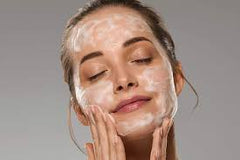Face Cleansers vs. Toners: Understanding Their Differences and How They Work
Posted on 12 September 2024 by Musab Zubair
Share this post

Face cleansers and toners are both important elements of a skincare routine, but they serve different purposes. While both work to keep your skin healthy and clean, their functions, ingredients, and how they’re applied are distinct.
In this blog, we will break down the differences between cleansers and toners, explain how each works, and address commonly asked questions. By the end, you'll know how to effectively use these products to achieve better skin health.
What is a Face Cleanser?
A face cleanser is a product designed to remove dirt, oil, makeup, and other impurities from your skin. This is the first step in most skincare routines because it preps your skin for the following products, like toners or moisturizers. Cleansers come in various forms, such as gels, creams, foams, and oils, catering to different skin types.
How Face Cleansers Work
Cleansers use ingredients that help break down oils, dirt, and pollutants on the surface of your skin. They contain surfactants, which are compounds that help bind water and oil, allowing you to wash away the grime. Some cleansers also include hydrating agents to avoid stripping the skin of its natural moisture.
Types of Cleansers
There are various types of cleansers available, each designed for specific skin types or concerns:
- Foam Cleansers: Ideal for oily or combination skin, foam cleansers effectively remove excess oil without being too harsh.
- Gel Cleansers: Great for acne-prone skin, as they are typically formulated to clean deep into pores.
- Cream Cleansers: Suitable for dry or sensitive skin, cream cleansers are rich in moisturizers to hydrate while cleaning.
- Oil Cleansers: These are best for dry skin, as they clean without stripping away natural oils.
What is a Face Toner?
A face toner is a liquid product applied after cleansing to remove any remaining impurities, balance the skin’s pH, and prepare it for moisturizers or treatments. Toners are known for their hydrating properties and ability to refine pores.
How Face Toners Work
After cleansing, your skin’s pH can be slightly off-balance, which can lead to dryness or oiliness. Toners work by restoring the natural balance of your skin, soothing it, and allowing better absorption of subsequent skincare products. Many toners also contain hydrating ingredients like glycerin or botanicals that can refresh and calm your skin.
Key Differences Between Cleansers and Toners
While both cleansers and toners help in maintaining skin health, they have distinct functions in your skincare routine. Here’s a breakdown of the major differences:
1. Purpose
- Face Cleanser: Cleansers are formulated to remove dirt, oils, makeup, and environmental pollutants. Their primary role is to clean the skin.
- Face Toner: Toners focus on balancing your skin’s pH, hydrating the skin, and preparing it for further treatments.
2. Texture
- Face Cleanser: Cleansers can come in various textures, from foams to oils, and are typically thicker in consistency.
- Face Toner: Toners are lightweight, water-based liquids that are easily absorbed into the skin.
3. When to Use
- Face Cleanser: Always used as the first step in your skincare routine.
- Face Toner: Applied after cleansing but before moisturizing.
4. Skin Benefits
- Face Cleanser: Cleansers keep your pores clean, reducing the chances of breakouts.
- Face Toner: Toners help shrink the appearance of pores and improve skin texture.
How to Use Face Cleansers and Toners Together
For the best results, both face cleansers and toners should be used in your daily skincare routine:
- Step 1: Cleanse – Start by wetting your face and applying your cleanser. Gently massage it into your skin in circular motions to remove dirt and impurities. Rinse thoroughly with lukewarm water.
- Step 2: Tone – After cleansing, apply toner with a cotton pad or by patting it directly onto your face. This helps to remove any leftover impurities and balance your skin’s pH.
- Step 3: Moisturize – Follow up with a moisturizer to lock in hydration and protect your skin throughout the day or night.
Using both products together ensures that your skin is not only clean but also ready to absorb other products like serums and moisturizers.
Commonly Asked FAQs About Face Cleansers and Toners
1. Do I Really Need to Use Both a Cleanser and a Toner?
Yes, cleansers and toners serve different functions, and using both can improve the overall health and appearance of your skin. The cleanser removes impurities, while the toner prepares your skin for further treatments by restoring balance and adding hydration.
2. Can I Skip Toner in My Skincare Routine?
While toner is not absolutely necessary, it can be highly beneficial, especially if you have oily or acne-prone skin. Toners help to reduce the appearance of pores and improve the texture of your skin. For those with dry or sensitive skin, a hydrating toner can help soothe and add moisture.
3. How Often Should I Use a Face Cleanser?
It’s recommended to use a face cleanser twice a day—once in the morning and once at night. However, if you have very dry or sensitive skin, you might opt for a gentle cleanser only in the evening to avoid over-washing.
4. How Often Should I Use a Face Toner?
You can use toner every time you cleanse your face. Toners are generally gentle enough for daily use, though some with strong exfoliating properties should be used only a few times a week.
5. What Ingredients Should I Look for in a Toner?
When selecting a toner, look for ingredients that suit your skin type. For oily or acne-prone skin, toners with salicylic acid or witch hazel can help control oil. If you have dry or sensitive skin, look for toners with hyaluronic acid or aloe vera to soothe and hydrate.
Choosing the Right Cleanser and Toner for Your Skin Type
Both face cleansers and toners come in a variety of formulations to suit different skin types. It’s important to choose products that cater to your skin’s needs.
For Oily Skin
- Cleansers: Choose a gel or foam cleanser that helps reduce oil and clears pores.
- Toners: Opt for a toner with ingredients like witch hazel or salicylic acid to control oil and minimize the appearance of pores.
For Dry Skin
- Cleansers: Use a cream or oil-based cleanser that cleanses without stripping the skin’s natural moisture.
- Toners: Look for hydrating toners that contain ingredients like glycerin, hyaluronic acid, or aloe vera.
For Sensitive Skin
- Cleansers: Choose a gentle, fragrance-free cleanser that won’t irritate the skin.
- Toners: Select alcohol-free, soothing toners with natural botanicals like chamomile or rosewater.
Final Thoughts on Face Cleansers and Toners
Face cleansers and toners play unique roles in your skincare routine. Cleansers help to remove dirt, oil, and makeup, while toners balance and hydrate your skin after cleansing. When used together, these products help keep your skin clean, balanced, and ready for further treatments like serums and moisturizers.
Choosing the right products for your skin type is crucial to getting the best results. So whether you have dry, oily, or sensitive skin, incorporating both a face cleanser and a toner into your routine can make a big difference in the health and appearance of your skin.





0 comments